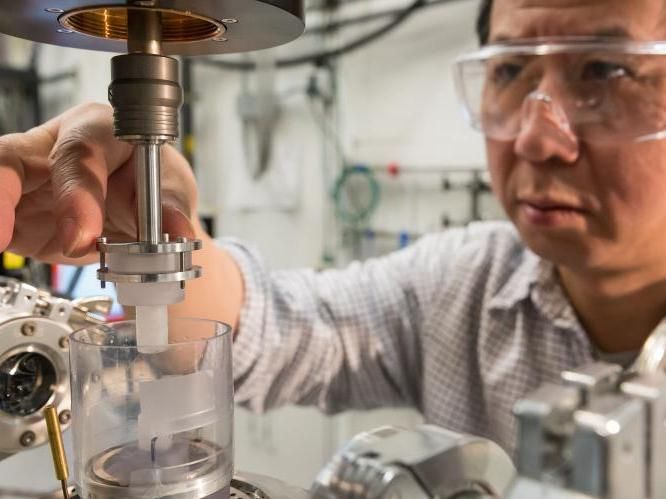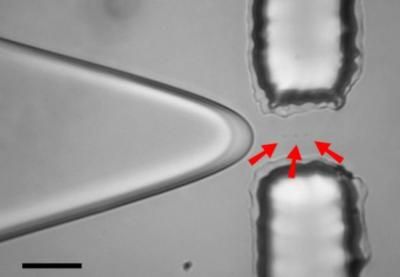Through thick and thin
Decades-old fluid question solved
What do paint, dishwasher detergent, ketchup and blood have in common? All are composed of particles suspended in a carrier liquid and flow when stirred or forced, but remain thick or even gel-like at rest.

Argonne nanoscientist Xiao-Min Lin works with the shear cell device that enabled the new discovery in shear-thickening fluids.
Argonne National Laboratory
That very useful behavior in complex fluids is called shear thinning: their viscosity decreases during mixing and increases at rest. But when the mixing speed increases—as required in many large-scale industrial processes—certain fluids can pass through the region of shear thinning and move into a region where viscosity increases dramatically, making them difficult or impossible to stir. This effect, known as shear thickening, has been under investigation for several decades as engineers sought to solve complex production problems caused by the phenomenon.
Now, a team of nanoscientists and physicists from Argonne National Laboratory has unraveled this 30-year mystery by studying a shear-thickening fluid with X-rays. The study could lead to applications in 3-D printing, the chemical industry and the biomedical field.
In the late 1980s, scientist Richard L. Hoffman proposed a simple model: When fluids are mixed at low speeds, the suspended particles form ordered layers that can slide easily across each other, facilitating flow. But when exposed to high speeds, the layers become disordered and stumble over one another, hindering flow; this change in the type of flow is called “order-to-disorder transition.” It’s a bit like a disorderly crowd, pushing and shuffling its way through a congested exit.
Other researchers were able to observe this behavior in many fluids, but not in every shear-thickening fluid. So scientists proposed several other models to explain the shear-thickening phenomenon, but none of them address Hoffman’s model.
“So the puzzle remains: how is order-to-disorder of particles related to shear-thickening behavior? Why does it happen only in certain complex fluids?” said Xiao-Min Lin, a nanoscientist with a joint appointment at the University of Chicago James Franck Institute and the Center for Nanoscale Materials at Argonne.
The team has always suspected that particle uniformity might play a role in this phenomenon. So Argonne postdoctoral fellow Jonghun Lee, the study’s lead author, synthesized silica nanoparticles of three different diameters. Then they took the samples to the Advanced Photon Source, a giant synchrotron at Argonne that provides extremely powerful X-rays for scientific analysis.
The team combined a rheometer, which measures the viscosity of the liquid, with X-ray characterization to create a unique instrument that can understand the structure of particles when they are moving in real time.
Their effort was rewarded. The highly uniform suspensions created by the team allowed them to separate the two phenomena: order-to-disorder transition and normal shear thickening. Until now, they had been indistinguishable in other experiments.
This allowed them to see that the order-to-disorder transition discovered in the 1980s occurs in lower-stress regions and the steady shear thickening occurs in higher-stress regions. In other words, these behaviors are driven by separate, independent mechanisms.
“But when you have non-uniform particles, these two behaviors collapse into the same region, making them indistinguishable,” Lee said.
Original publication
Other news from the department science

Get the analytics and lab tech industry in your inbox
By submitting this form you agree that LUMITOS AG will send you the newsletter(s) selected above by email. Your data will not be passed on to third parties. Your data will be stored and processed in accordance with our data protection regulations. LUMITOS may contact you by email for the purpose of advertising or market and opinion surveys. You can revoke your consent at any time without giving reasons to LUMITOS AG, Ernst-Augustin-Str. 2, 12489 Berlin, Germany or by e-mail at revoke@lumitos.com with effect for the future. In addition, each email contains a link to unsubscribe from the corresponding newsletter.

























































